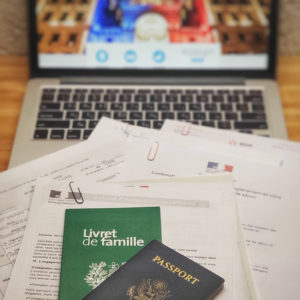Everything you need to know about French visa terminology
The first step in your stay/move abroad will most likely require a visa. What is a visa ? This is either a stamp or a piece of paper (usually in the form of a sticker that is fixed in your passport) that allows the holder entry and exit as well as the ability to remain in a foreign territory for a specific period of time. Visas come with different rules and stipulations depending on the country and the type of visa that is issued.
Some visas need to be applied for in advance and from your home country. The application process can include various types of documents proving financial stability, reason(s) for travel, and examples of previous entry into the country. Each country has different requirements and it is recommended that you looks at your local consulate’s website for the specific country.
Here I will be explaining the terms and definitions that come along with French visas. Hopefully this will help you better understand and navigate the murky waters that can be French visa and their applications. You can click here to fill out the wizard with your personal situation details to help figure out which visa you will need to apply for.
French Visa Terminology
Visa Types
Visa de court séjour (Schengen visa)
This is a short-stay visa that allows the holder to enter France (or the Schengen region) under certain stipulations. It allows the holder to stay up to 90 days, uninterrupted, within a period of 180 consecutive days. It is a single-entry visa, meaning that once you leave, you will need to reapply to re-enter the country again.
Here are some reasons you may need a short-stay visa:
- visiting as a tourist.
- visiting for pleasure, family or personal reasons.
- visiting for business reasons.
- short-term internships.
- being paid for certain employment situations.
Find more information here for Americans interested in short-stay visas.
Click here for more information on the documentation that you will need to present at the border on arrival in France.
For more information from the Interior Minister of France, you can click here to read about the visa de court séjour.
Visa de long séjour
This is a long-stay visa that allows the holder to enter France and stay in France from 90 days to 12 months. If you want to extend your stay beyond the 12 months, you will need to apply for a residence permit at the préfecture.
Here are some different reasons for obtaining a long-stay visa :
- Tourist or personal reasons.
- Professional activity.
- Education.
- Join family members.
If you have a visa long séjour valant titre de séjour, this is a visa that is serving as a residency permit once it has been validated upon arrival in France. This type of long-stay visa has different stipulations.
Find more information here for Americans interested in long-stay visas.
For more information from the Interior Minister of France, you can click here to read about the different types of long-stay visas for France;
Residency Permit
Titre de séjour
This is a residency permit, a document that is recognized publicly as the right to reside in a country by a foreign national. A residency permit is defined by its legal nature, the reason of entry, and the period of validity.
There are five main types of titres de séjours :
- visa long séjour valant titre de séjour.
- carte de séjour temporaire.
- carte de séjour pluriannuelle.
- carte de résident.
- carte de séjour “retraité”.
See below for further descriptions.
Visa long séjour valant titre de séjour
This is a long-stay visa that is the equivalent to a residency permit once validated upon arrival in France. You do not need to apply for a separate residency permit, as it already considered one. The visa needs to be validated within the first two months of arrival in France. The permit can be renewed starting up to two months before the expiration of the visa.
This is the visa that I came to France on; you can read about my experience with the visa and the whole process here.
Carte de séjour temporaire
A residency permit that grants the holder the right to stay for one year, renewable after a year. There are different stipulations in regards to the temporary residency permits : worker, student, and family ties. After the first year, the card is renewed for a multi-year card, valid up to 4 years, depending on the situation of the permit. This permit allows you to work in France, but there are some restrictions.
Carte de séjour pluriannuelle
A residency permit that allows the holder the right to stay for several years before renewing the permit. This applies to the 10 different situations, worker and family ties are just two examples. You are allowed to work in France with this permit.
Carte de résident
This is a residency permit that is valid for 10 years. This card is available to those foreigners who have been living in France for a minimum of five years. You are allowed to work in France with this permit.
Carte de séjour "retraité"
This is a residency permit (titre de séjour) that is valid for 10 years and is renewable. This card is available to those foreigners who have been employed on a carte de résident and currently recieve a pension from the French government.
Récépissé
This is a receipt that is given when the first request for renewal is made to the residency permit when it expires. This acts as the residency permit and has all the same rights as the permit. This is given out and valid until the new residency permit is produced and issued. It will be rendered during the appointment to pick up the new permit.
AGDREF
This is known as the Application des Getions des Dossiers des Ressortissants étrangers en France. This is an electronic database that centralizes all the applicants information and data in one place so that all French administrative branches have access to the applicant’s file and data. This is also your number that is assigned to you when your visa is created. It consists of 9 or 10 number that usually start with your département or 991 if you had a VLS-TS. I found my on my visa validation letter.
CESEDA
This is the code de l’entrée et du séjour des étrangers et du droit d’asile in France. These are the rules that apply to the entry of foreigners that wish to install in France. It was created in 2003 and put into effect in 2005.
If you wish to dig into the details of this law, you can click here for full access.
OFII
CIR
Contrat d’intégration républicaine. The Republican integration contract. This is an agreement between the foreign national and the nation of France. There are regulations that need to be met before the first multi-year residency permit can be issued. This includes a medical exam, an orientation and interview with a state agent, a language exam, civics formations and a workshop on integrating professionally. This is all done through OFII.
Click here to read about what the contract includes and the commitments that come with it.
Read about when I signed my CIR here.


You May Also Like

Exchanging my Ohio license for a French permis de conduire
17 January 2021
How I renewed my VLS-TS: VPF titre de séjour
4 January 2021